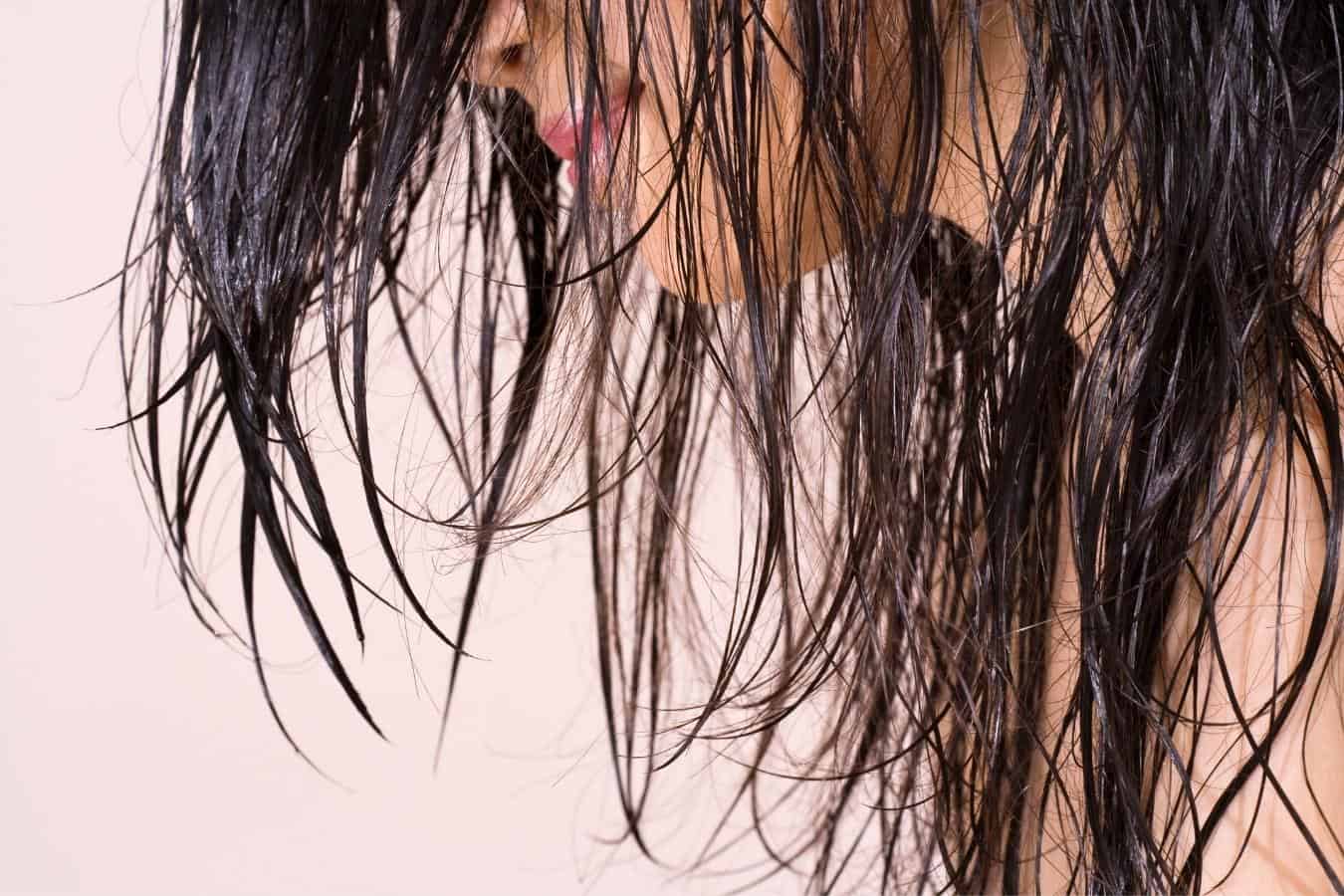If you are having problems because your hair does not absorb water, you might be wondering what’s going on. You add products and water, but your hair stays dry and feels stiff and coarse.
In this article, I offer five easy ways to fix this problem.

Why Won’t My Hair Absorb Water?
If your hair won’t absorb moisture, there is probably an issue with the porosity being too low.
Your hair is covered in many tiny pores, and these can allow water and other products to pass through if they are large enough – but if they are small, your hair will not easily absorb anything at all.
Even water molecules will be too big to easily pass into the hair, and this means that it has very low absorbency overall.
Think about this like making multiple holes in a pipe but keeping them very small.
If you then run water over this surface, very little water will soak through the holes and into the pipe, because the holes are so small. It is hard for the water to pass through them.
However, once water is in there, it will be trapped much more effectively, for exactly the same reason.
The holes are so small that they minimize and mostly prevent the exchange between the inside of the pipe and the outside. It is hard for anything to pass in either direction.
Your hair will not absorb much water because there is no way for the water to get into your hair.
Equally, your hair should not dry out too fast once you have got water or a product into it.
This can be a benefit, but not being able to get the water in initially is quite frustrating for many people.
What Are The Common Issues With Hair That Won’t Absorb Water?
If your hair won’t absorb water, you probably find that it ends up very dry. This is because it also cannot absorb products effectively.
That means that when you try to moisturize your hair, the moisturizer is likely to sit on top of it, rather than soak in.
Your hair may feel dry and brittle, even after it has just been washed.
This is intensely frustrating, and you won’t be able to get products to absorb easily because the shaft’s pores are so small.
A further problem is that dyes may not take very well. Because the hair shaft doesn’t allow molecules to penetrate it easily, dyes won’t be able to get inside – and this is necessary if they are to adhere to your hair.
On the other hand, once you have got dyes to take, they should last well, because they won’t wash out nearly as fast.
How Do I Make My Hair Absorb More Water?

If you are having problems with your hair not absorbing water, you might be wondering what you can do about this.
There are a few things that will help to increase the absorbency of your hair, and some of these include:
Use Heat
Use heat whenever you are washing your hair or applying a product to it. This will open up the cuticle and expand the pores so the water can more easily get in. Once inside, water (and products) should stay there.
Avoid Alcohol
Avoid products that contain alcohol, as this pulls moisture out of your hair and will make it dryer. Even if the alcohol isn’t absorbed by the hair because the porosity is low, it may cause issues.
Don’t Use Silicone products
Don’t use any products with silicone in them. Silicone products coat your hair and make it even more difficult for it to absorb moisture. Look out for shampoos and conditioners that do not contain silicone and use these instead.
Consider vitamins
Take vitamins such as iron, Vitamin D, and Vitamin B12, as these will all contribute to healthy hair. They will not necessarily increase absorption but they will make your hair feel nicer.
Conditioners can provide moisture
Try conditioners to see if they can improve the moisture in the strands. You may want to look into deep conditioning methods that use heat to open up the cuticles and let the moisture soak in.
You should also talk to your stylist for suggestions about how to make your hair more absorbent, as they may have ideas specific to you.
How Do I Keep Water In My Hair?

If you can’t easily get water into your hair, you are probably very anxious to keep it in once it is there. However, you don’t actually need to worry about this too much, because your hair won’t lose moisture readily if its porosity is low.
Instead, the water is likely to stay trapped there. It can’t escape easily for the same reason that it can’t get in easily.
However, there are still a few things that you should be aware of when handling hair that doesn’t absorb moisture:
Don’t worry too much about heat
A lot of people have to be careful when using straighteners or curlers and avoid hairdryers because these strip moisture out of the hair if the hair is porous.
They also make it more porous by raising the cuticles.
However, if you have low-porosity hair, you don’t need to worry too much about heat. A little more water will be able to escape from your hair if you heat it, but this shouldn’t be excessive.
Heat caps are a great way to deep condition your hair too, so consider this.
Don’t use buttery, oily products
The heavier the products are, the more they will build up on your hair and coat it, preventing it from absorbing moisture.
If you frequently add oils (especially if you only wash your hair every few days), it will be harder for the water to penetrate your hair when you next wash it.
If you do use such products, you may notice that your hair gets weighed down by the oils and looks heavy and flat.
This is because the oils are sitting on the surface, rather than being absorbed. It isn’t addressing the dryness problem – it’s just coating it.
Avoid leave-in conditioners
They are usually packed with proteins that are intended to strengthen the hair cuticle, but hair that doesn’t absorb water usually has strong cuticles already and is unlikely to need these.
Instead, opt for light moisturizers or conditioners.
How Do I Know If My Hair Is Porous Or Not?

You may be able to tell whether your hair is porous simply by how it behaves when you get it wet.
If the cuticles are tightly packed and the pores are small, the water will roll off more easily. Your hair will not soak up much and may dry quite quickly.
If your hair is high porosity, it will soak up a lot more water, but it should still dry fast because the moisture exchange between your hair and the air is quicker.
More water is absorbed, but it can evaporate much more quickly.
It may not be easy to judge whether your hair is porous just from its drying speed, but here’s how to tell:
The Porosity Test
- Wash your hair so that it is clean and free from oils.
- Pull out one strand of hair and set up a glass of water.
- Allow the water to reach room temperature (you do not want to use hot water for this test).
- Drop the strand into the glass and watch to see how it behaves.
If your hair sinks when it hits the water, you have very porous hair, and it is absorbing the water quickly. If your hair floats, you have low porosity hair, and it is not absorbing the water.
It should stay on the surface even after several minutes have passed. Anything in between equals medium porosity.
Hot water will spoil the results as it will cause the hair to expand and absorb water, even if it is not porous.
Some people argue that the test is inaccurate because there are too many variables, but many do recommend this test.
If you aren’t sure about it, you can also test your hair’s porosity using a spray bottle. Fill it with room temperature water and spray your hair all over and see how it behaves.
If the water beads up on your hair and then rolls down, rather than soaking in, it’s likely that your hair is low porosity.
Similarly, you can simply assess how quickly your hair absorbs water when you wash it. If it gets wet fast, it’s got high porosity. If it seems to repel the water, it’s probably low porosity.
What Causes Low Porosity?
Low porosity in hair is not uncommon, and many people have this issue.
It is usually a result of the cuticles being pressed closely together, and it is not caused by environmental factors the way that high porosity hair is. It is about genetics, so if others in your family suffer from low porosity hair, you are more likely to as well.
Your hair porosity may be increased if you:
- Straighten your hair
- Curl your hair
- Blow-dry your hair
- Otherwise apply heat to your hair
- Use certain harsh chemicals that raise the cuticle and expand the pores
- Use harsh shampoos or wash your hair very frequently
Remember that both low and high-porosity hair can be problematic, but low-porosity hair will not absorb water as well as high-porosity hair.
Conclusion
If your hair won’t absorb water, it’s likely because the pores are very small, and therefore the water molecules cannot pass through into the hair shaft.
You will need to wash your hair in warm water and use heat to open up the pores to decrease this issue. Avoiding certain products, like silicone, may also help.
Frequently Asked Questions (FAQ)
Both of these hair types have problems. High porosity hair absorbs but loses products quickly. Low porosity hair does not absorb them well but holds onto them once it has absorbed them.
No – you may want to avoid using products that are specifically heavy in protein, but most hair benefits from having protein added.
References
How to Care for Low Porosity Hair
https://www.healthline.com/health/low-porosity-hair
4 Things You Can’t Do When You Have Low Porosity Hair
https://www.naturallycurly.com/curlreading/learn/6-things-you-cant-do-when-you-have-low-porosity-hair-bi
Hair Porosity
https://curlmaven.ie/hair-porosity/
How to Moisturize Your Stubborn, Low Porosity Hair
https://www.naturallycurly.com/curlreading/learn/how-to-moisturize-your-stubborn-low-porosity-hair-bi
Disclaimer: This site is not intended to provide professional or medical advice. All of the content on LovedByCurls.com is for informational purposes only. All advice should be followed at your own discretion. Ingredients may change at any time so always check the product label before using. Check our full disclaimer policy here.
